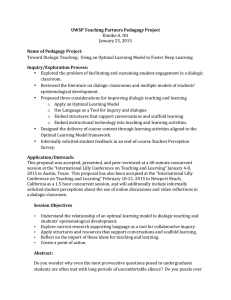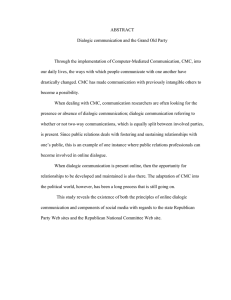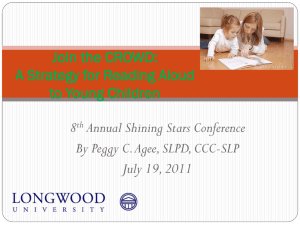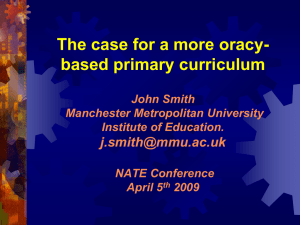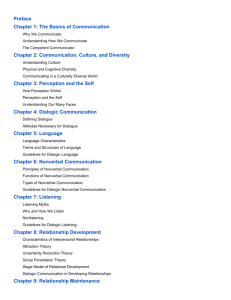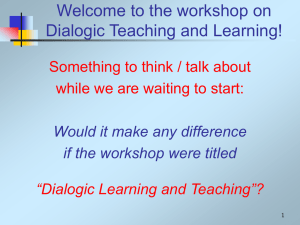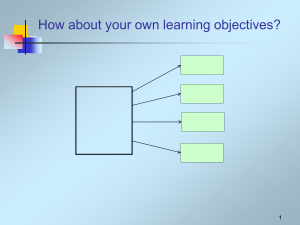Powerpoint slides (opens as )
advertisement
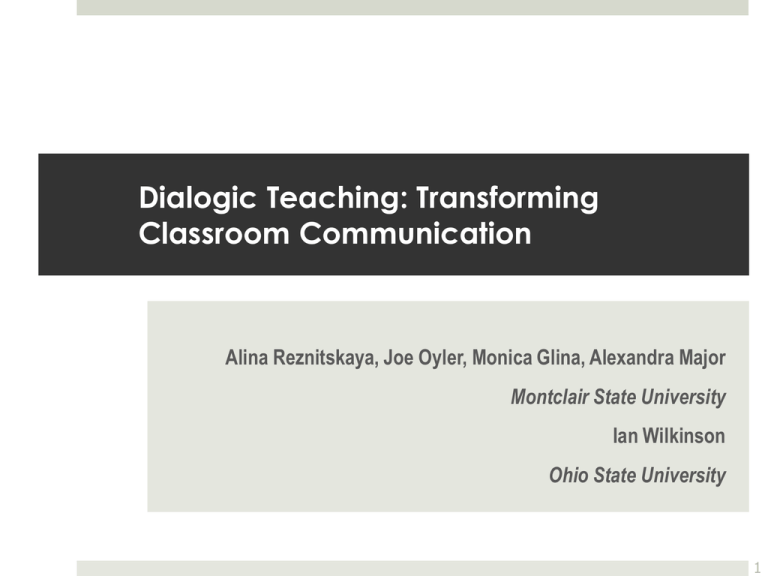
Dialogic Teaching: Transforming Classroom Communication Alina Reznitskaya, Joe Oyler, Monica Glina, Alexandra Major Montclair State University Ian Wilkinson Ohio State University 1 Sponsor The Institute of Education Sciences, U.S. Department of Education Grant # R305A120634 2 Demonstration What Should Kelly Do? 3 WHY? What is the value of having this kind of discussions for the students? 4 WHY: Argument Literacy To improve students’ ability and predisposition to comprehend, evaluate, and formulate arguments, or argument literacy “This, it seems to me, is a fine and noble story to offer as a reason for schooling: to provide our youth with the knowledge and will to participate in the great [American] experiment; to teach them how to argue, and to help them discover what questions are worth arguing about, and, of course, to make sure they know what happens when arguments cease” (Postman, 1995, pp. 73-74). 5 HOW: Dialogic Inquiry Dialogic Inquiry is an approach to teaching that involves students in the collaborative construction of meaning and is characterized by shared control over the key aspects of classroom discourse. • Philosophy for Children (Lipman, Sharp, & Oscanyon, 1980), • Collaborative Reasoning (Waggoner, et al., 1995) • Paideia Seminar (Billings & Fitzgerald, 2002), • Junior Great Books Shared Inquiry (Great Books Foundation, 1987) 6 HOW it works: Theory and Research Theory: Social constructivism (e.g., Vygotsky, Piaget, Wells, Halliday) Learning occurs through “the mastery of devices of cultural behavior and thinking” Students internalize the “new tools” or “resources of culture” through interaction. Research: improved reasoning (Kuhn & Udell, 2003; Mercer,Wegerif, & Dawes,1999), enhanced quality of argumentative writing (Applebee et al., 2003; Reznitskaya et al., 2001), increased comprehension and argumentation about text (e.g., Murphy et al., 2009). 7 From Group to Individual Arguments ARGUMENT: Positions Reasons Warrants Challenge Response to Challenge ( My position is… because the text said… However, others might think… 8 Monologic-Dialogic Continuum MONOLOGIC The teacher has exclusive control over discussion. S/he introduces topics, nominates students, asks questions, and evaluates answers. DIALOGIC Students participate in the collaborative construction of knowledge. They share control over the key aspects of classroom discourse. 9 Dialogic inquiry is largely absent from classrooms Classroom interactions typically tend towards monologic (e.g., Alexander, 2005; Mehan, 1998; Nystrand, et al., 2003). Nystrand describes “orderly but lifeless classrooms” where teachers continue to “avoid controversial topics” and where students routinely “recall what someone else thought, rather than articulate, examine, elaborate, or revise what they themselves thought.” Learning to implement dialogic practices presents a serious challenge for both novice and experienced teachers (Juzwik, Sherry, Caughlan, Heintz, & Borsheim-Black, 2012). 10 So…. WHY: Argument literacy is a fundamental academic and life skill HOW: The development of argument literacy is best supported through dialogic inquiry BUT… Teachers rarely use dialogic inquiry in their classrooms. SO…. WHAT should be done to help teachers learn to use dialogic inquiry? What should teachers know and be able to do? How should we teach relevant knowledge and skills? 11 WHAT Should Teachers Know and Be Able to Do? Well-balanced mix of relevant beliefs, knowledge, and skills Real change happens only when “teachers think differently about what is going on in their classrooms, and are provided with the practices that match the different ways of thinking (Richardson et al., 1991, p. 579). Theories of knowledge, teaching, and learning Knowledge and skills of argumentation Knowledge and skills of facilitation: strategic moves 12 YEAR 1: Processes Two sites 4 teachers at MSU 6 teachers at OSU Bi-weekly study groups Min-lectures Discussions Demonstrations Readings Activities Exercises Videotaping and coaching 3 Focus Groups Systematic Assessment of Classroom Talk: Tools 13 YEAR 1 Products Curriculum materials Readings Power-points Activities, exercises Handouts Data Audiotaped study-group meetings Videotaped classroom discussions Audiotaped coaching sessions Teacher ratings of their discussions using observation measures Audiotaped focus groups Years 2 and 3 Reiterative revisions Testing the effects on students’ argument literacy 14 Study Group Meetings: Teacher Comments “I have enjoyed the readings and found they brought me some clarity. Reading that “students are active meaning makers, who can progress to higher levels of cognitive development through their interaction with the environment” was the push my class needed to start thinking and, with some encouragement, they started thinking about their own thinking a little more.” “Each time I come to a session, I am excited by the end to continue to ponder what we’ve discussed. I feel we are really getting to the meat of it now. It was particularly helpful when we demonstrated the method of inquiry and modeled the discussion through the group. It helped put the pieces together for me.” I also really enjoyed having Joe run the one session for the story "A Trip to the Zoo" and seeing how it can really take so many turns and how he put it all together.” “…while the readings are informative, I really feel like that's where you'd run the risk of losing people.” “I think one thing I might do differently is in terms of watching videos as a group; I'm not sure if that helped me at all.” “When my video is up there, I wanted to kinda talk my way through it, explain what I did. ‘Why should I do this? What should I have done there?’ I think that then cuts the time cause I have so many questions. When it's your video up there you have a lot of questions about what you're doing. 15 Videotaping and Coaching: Teacher Comments “Working one-on-one with someone who regularly uses these strategies will be awesome. I thought coaching to be the most helpful because it was…watching the video with purpose. It was almost like being accountable to watch the video even though I'd watched the other videos, but it was just watching it knowing I had to bring something more than just whatever came up. 16 Assessment Tools: Teacher Comments About the Accountable Talk Tool: “It wasn't harmful. I did find myself thinking about other things. …I just didn't feel the amount of time it took to kind of fill it out was equal to how useful it was. It wasn't without use but in terms of how much went in to filling it out, I don't know how much more sparkling my thinking about the actual conversation was.” About the Dialogic Inquiry Tool: “Trying to just track all the different, it's just too much stuff happening in those things. It's so hard to keep track. You do one thing but you didn't do three other things or whatever it ends up being. So just focusing specifically on 'did you ask for evidence?' or ‘where could you have found times to ask for warrants’ or whatever. 17
